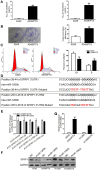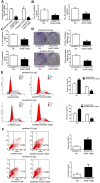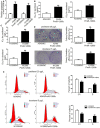miR-1260b Activates Wnt Signaling by Targeting Secreted Frizzled-Related Protein 1 to Regulate Taxane Resistance in Lung Adenocarcinoma
- PMID: 33224874
- PMCID: PMC7674592
- DOI: 10.3389/fonc.2020.557327
miR-1260b Activates Wnt Signaling by Targeting Secreted Frizzled-Related Protein 1 to Regulate Taxane Resistance in Lung Adenocarcinoma
Abstract
Objectives: MicroRNAs (miRNAs) have been demonstrated to contribute to carcinogenesis; however, their association with tumor chemoresistance is not fully understood. In this study we aimed to investigate the molecular mechanisms involved in resistance to taxane-based chemotherapy in lung adenocarcinoma (LAD). Methods: We established paclitaxel-resistant A549 cells (A549/PTX) and docetaxel-resistant H1299 cells (H1299/DTX). In order to hit the mark, we employed multiple methods including qRT-PCR, western blotting analysis, loss/gain-of-function analysis, luciferase assays, drug sensitivity assays, animal experiment, wound-healing assay, and invasion assay. Results: Bioinformatics analysis and a luciferase reporter assay revealed that secreted frizzled-related protein 1 (SFRP1) is a direct target of miR-1260b. By qRT-PCR analysis, we found that miR-1260b was significantly upregulated in taxane-resistant cells as compared to parental cells. Suppression of miR-1260b reversed the chemoresistance of human LAD cells to taxanes both in vitro and in vivo, whereas ectopic miR-1260b expression decreased the sensitivity of parental LAD cell lines to taxanes. Downregulation of miR-1260b expression inactivated the Wnt signaling pathway and reversed the epithelial-mesenchymal transition (EMT) phenotype of taxane-resistant LAD cells. In clinical tumor tissue samples, high miR-1260b expression was detected in tumors of non-responding patients treated with taxane-based chemotherapy and was associated with low SFRP1 expression and poor prognosis. Conclusions: Our findings reveal that targeting of the miR-1260b/SFRP1/Wnt signaling axis might provide a novel strategy for overcoming chemotherapy resistance in LAD.
Keywords: SFRP1; Wnt signaling; chemoresistance; lung adenocarcinoma; miR-1260; taxane.
Copyright © 2020 Ren, Wang, Huang, Li, Zhuang and Li.
Figures








Similar articles
-
MiRNA-26a Contributes to the Acquisition of Malignant Behaviors of Doctaxel-Resistant Lung Adenocarcinoma Cells through Targeting EZH2.Cell Physiol Biochem. 2017;41(2):583-597. doi: 10.1159/000457879. Epub 2017 Feb 3. Cell Physiol Biochem. 2017. PMID: 28214878
-
Secreted frizzled related protein 1 modulates taxane resistance of human lung adenocarcinoma.Mol Med. 2014 Apr 8;20(1):164-78. doi: 10.2119/molmed.2013.00149. Mol Med. 2014. PMID: 24643460 Free PMC article.
-
Long noncoding RNA ROR regulates chemoresistance in docetaxel-resistant lung adenocarcinoma cells via epithelial mesenchymal transition pathway.Oncotarget. 2017 May 16;8(20):33144-33158. doi: 10.18632/oncotarget.16562. Oncotarget. 2017. PMID: 28388536 Free PMC article.
-
MicroRNA-451 induces epithelial-mesenchymal transition in docetaxel-resistant lung adenocarcinoma cells by targeting proto-oncogene c-Myc.Eur J Cancer. 2014 Nov;50(17):3050-67. doi: 10.1016/j.ejca.2014.09.008. Epub 2014 Oct 10. Eur J Cancer. 2014. PMID: 25310895
-
MicroRNAs: key players of taxane resistance and their therapeutic potential in human cancers.J Cell Mol Med. 2013 Oct;17(10):1207-17. doi: 10.1111/jcmm.12131. Epub 2013 Sep 23. J Cell Mol Med. 2013. PMID: 24106980 Free PMC article. Review.
Cited by
-
Fibroblast-derived extracellular vesicles contain SFRP1 and mediate pulmonary fibrosis.JCI Insight. 2024 Aug 15;9(18):e168889. doi: 10.1172/jci.insight.168889. JCI Insight. 2024. PMID: 39315549 Free PMC article.
References
LinkOut - more resources
Full Text Sources
Research Materials

